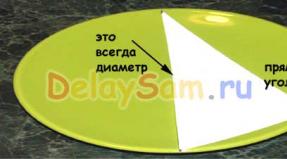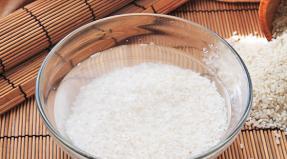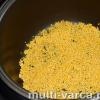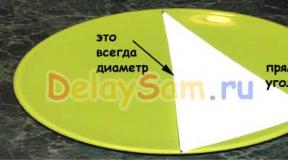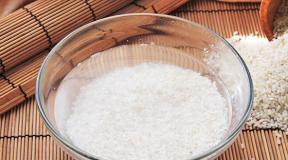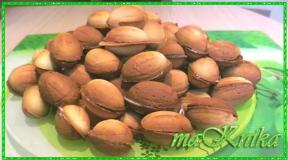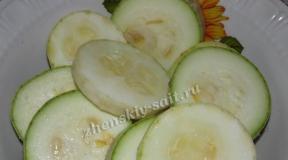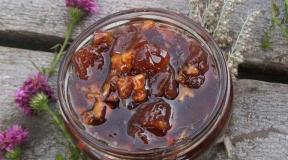A desk for a schoolchild, adjustable with your own hands. Erisman's school desk. Correct child posture when reading and writing. Components of a children's desk
When a child goes to school, having a special place in the house where he will now do his homework becomes a necessity. It should be a comfortable, always separate, table or desk, located in a well-lit place, preferably by a window.
There is absolutely no need to use a bulky design. In a student’s life there should be room for games, sports, hobbies, and creative activities. The fewer unnecessary items a desk can accommodate, the better the student will be able to concentrate on a particular activity.
When choosing the best option for your conditions, consider various tables made of chipboard, plywood, and wood. There are folding, retractable, corner, and straight designs. Anyone can make a simple and functional desk for a schoolchild with their own hands. It will be enough for a junior high school student. As the child grows and the number of subjects studied increases, the desk can be supplemented with hanging shelves, separate bedside tables, and shelving.
The first workplace for a student
Before you make a desk for a first-grader with your own hands, carefully examine the drawings. You can adjust the height of the legs depending on the height of your child. For example, if students are up to 115 cm tall, tables should be no higher than 46 cm, and if students are 130 cm tall, tables should be no higher than 50 cm. 

Materials and tools
- Laminated chipboard sheet.
- Edge for ends.
- Iron.
- Furniture screws.
- Electric drill.
- Drills.
- Wood glue.
- Square, tape measure.
- Screwdriver.
- Decorative plugs for screws.
In accordance with the dimensions contained in the drawings or your data, cut the necessary parts from chipboard. If you have experience in such work and the appropriate equipment, you can do it yourself. An easier option is to order cutting at the place where you purchased the chipboard. They will also help you with gluing the ends with a special edge.
Job Description

You will appreciate the advantages of this simple model: it is easy to make with your own hands, it is neat, and you will find a place for such a desk for a first-grader even in a very small room. In addition, desks (like other products) made of chipboard can be painted in any color that matches the interior of the room.
A place to study and write
Time goes by quickly, and now you need something more than just a children's desk. An interesting model for middle and high school students would be a compact table made with your own hands. You can not only do your homework behind it, but also put your student’s writing materials, notebooks, and first scientific projects in numerous drawers and compartments. The option we propose is more suitable for a classic interior.
This desk has a height of 90 cm, a width of about 94 cm, and a depth of 55 cm. If such a product is too tall for you, the length of the legs can be adjusted when making it yourself. This piece of furniture can be classified as furniture of medium complexity. Be attentive to details, and the job description and drawings will help you complete the job and be satisfied with its result.
Materials for making a desk
To get started with your DIY work, prepare the following materials:
- The main material is 18 mm thick hardwood furniture board. Instead, you can take laminated chipboard, gluing the ends of the parts with edge tape.
- Plywood 10 mm thick.
- Wooden dowels.
- Self-tapping screws.
- Finishing nails.
- Wood glue.
- Acrylic varnish.
Tools you will need:
- Jigsaw.
- Circular saw.
- Electric drill.
- Milling machine.
- Grinding machine, nozzles of different grain sizes.
- Clamps.
- Hammer, hacksaw.
- Tape measure, square, pencil.
A detailed drawing of the table will provide the dimensions of the necessary elements and demonstrate their installation locations. 
Description of the work procedure

Attention! A handmade desk should turn out neat. Therefore, protruding excess glue must be wiped off immediately with a dry cloth.
First of all, connect the drawers and legs along the short sidewalls, after the glue has dried, add longitudinal drawers. Tighten the joints with clamps until dry. The base for the desk is ready.
- Cut a slab of furniture board (or chipboard) 936x550 cm for the table top and the top cover of the shelves. Select the slots to install the right compartment divider. Use a thin cylindrical router bit to cut the grooves. Also make the outer edges of the parts smooth.
On a strip of plywood (10 mm thick), make markings with your own hands for 4 vertical partitions 150x135 mm. Cut them out and glue the front edges of the wood.
- Using a special cutter, we select grooves 10 mm wide in the top cover of the shelves. They will help secure the partitions with the top cover. To make the groove even, while working, move the cutter along the block held by the clamp.
- Cut grooves for dowels in the edges of the side walls, partitions, and top cover. Use glue to connect all these parts.
- From plywood (10 mm thick) you need to cut out the components for the drawers. Assemble the boxes by gluing the joints, and additionally fasten them with finishing nails. Attach the facing panels to the front walls from the inside with 2 self-tapping screws.
- Our desk has figured side walls. Prepare a template from cardboard. Using an electric jigsaw, use it to cut out both panels, which will assemble the entire desk. Remove the chamfers from the edges and sand them.
- Cut out all intermediate partitions and shelf. Assemble the entire shelf structure and curly sides using glue. Tighten the structure with clamps and leave until completely dry.
- Secure the table with self-tapping screws to the base.
- As a final finish, coat the product with 1-2 layers of furniture acrylic varnish.
Any student class, from the youngest to the graduate, required place to study lessons.
Desk for schoolchildren should be functional, convenient and uncluttered. Most often chosen for children wooden desks.
Today, when from the first grade students work with computer, there should be room on the table for it too.
Manufacturing DIY school table - significant saving for the family budget. You can decorate the tabletop in the most incredible ways, and then the table you made yourself will look like an expensive designer thing.
School desk options
Table for first graders should be spacious so that there is enough space for textbooks and notebooks.
For more adult student, you can purchase or make a multifunctional table with retractable panel for keyboards and with many shelves or drawers on the surface.
It is very important that workplace the child was as comfortable as possible, and all the necessary for classes things were at hand.
School tables can be completely various in appearance and design - from simple angular and straight to creative
Folding table

Table-desk

Desk for schoolchildren
 We won't consider typical desks that stood in all Russian apartments in the 90s of the last century. Such tables boring in execution.
We won't consider typical desks that stood in all Russian apartments in the 90s of the last century. Such tables boring in execution.
Let's consider unusual table with A-shaped legs (trests) and solid long tabletop. You can use an old one as a countertop door canvas with a smooth surface.
Stages of work
Step 1. Draw and cut out table top. We process it with sandpaper or a grinding machine. You can make a special edging on the sides finishing edging, which is sold at any hardware store.
Please note: with the edging, the width of the finished tabletop will be 72 cm!
Step 2. Cut 8 boards long no less 75 cm (if necessary, the edges will need to be trimmed with a jigsaw), sand them.
Step 3. Corner tilt boards for trestles should be such that the height of the legs in total with the thickness of the table top was 75 cm. To do this, cut out small bars, which will be located between the upper parts of the supports. The width between the lower parts should be 22 cm.

Step 4. In two boards 70 cm long drill two 9 mm holes each (for mounting the trestle). The holes should be equal distance! Above retreat about 3.5–4 cm, it all depends on the width of the board. Drill holes in the middle of the upper part of the legs 9 mm. Furniture bolts we fasten legs and strengthen the structure self-tapping screws.
Please note: The bolt size is 6 mm, and the diameter of the holes for them is 9 mm! This is necessary because the table legs are attached at an angle.
Step 5. At the bottom there is a goat we fix two bars long 19 cm. The height of the fastening of the bars is not less than 3 cm from the floor. On bars we lay two boards each that will serve shelf, we secure them with self-tapping screws.

Step 6. Having measured the distance between the goats, screw it on wooden blocks to prevent the tabletop from moving.

For the best sustainability It is recommended to use countertops dowels. To do this, drill holes in the supporting boards with a depth of 8 mm, and in table top – 22 mm. The dowels should be dipped in glue PVA and drive into the board, then carefully place the tabletop on them. For such massive table you need to make 2-3 dowels on each side.

Step 7 All wooden parts of the table should be process impregnation. For a children's table you need to apply no less 3 layers(so that it is impervious to moisture). Each layer should fully dry out. After the last layer has dried, the table is painted or varnished. Can be mixed with varnish a little coloring to give it the desired color shade.
Please note: The table can be decorated if desired. The best decorative technique for a children's table is simply choosing a cheerful picture or decorating the tabletop with images of your child's favorite characters.
School table for two children
Convenient and practical may be an option for two children angular table. Each child is provided with a work place and retractable drawers for storing educational supplies.
Tabletop width – 600 mm, thickness – from 16 mm.
Stages of work
Step 1. Execute sawing material or order it from a carpentry workshop.

Step 2. Collecting everything boxes. There should be 6 large ones (3 pieces for each table base) and 4 small drawers for various small items under the tabletop itself. Holes for confirmations drill using a Fostner drill. We nail hardboard to each box.
Please note: confirmations can be replaced with ordinary self-tapping screws, but their connection is not so reliable.
Step 3. Using corner clamps assembling the cabinet. Fasten with self-tapping screws guides for boxes.

Step 4. We assemble the table. Tumbu and lateral We fasten the wall on top with small chipboard. Cover the part with a larger sheet rear walls. We install guides on small drawers and facades.

Step 5. In the same way we collect second the table that will longer due to two cabinets.
Step 6. We install the tabletop on short table. To do this, screw it onto small sheets.
Step 7 We attach the tabletop to second table.

Step 8 Install facades on large boxes, attach to them pens. We nail hardboard.
 So that the child has comfortable work at a new table, you should take into account following:
So that the child has comfortable work at a new table, you should take into account following:
- Width The table for a child should be from 60 to 80 cm, length from 120 cm.
- Boys require more workspace than girls.
- Workplace It is recommended to organize a schoolchild at the window.
- Definitely worth installing on a desktop lamp with bright lighting. For right-handers, the light should fall from the left, for left-handers - from the right.
- The chair should be comfortable, it back - rigid with bending. Good solution - orthopedic armchair.
- Screen monitor should be located during operation below eye level at an angle of 15-30 degrees.

- Color range The workplace should be selected based on the child’s wishes, but you should not make it too colorful and full of poisonous colors. A tacky table can distract child from doing homework. It is enough to choose bright accessories and furniture.
- Accessories are worth choosing creative shapes: and the children's table should have its own zest. Business minimalism – not the best option for a child.
How to make a table for a schoolchild with your own hands, see video:
How to make a children's table so that it can be both an original desk for the child and at the same time a playhouse for toys. In this article we will tell you how to do all this in one day.
Many parents prefer to buy a ready-made table for their child and not bother. But there are also those who simply cannot afford it. Or they like to do everything with their own hands and to the required dimensions of their interior. The advantage of this table is its versatility. This is a desk, a playhouse, and a place to store toys.
In order to make a wooden desk, you need to purchase material, a sheet of furniture chipboard, of a suitable color. Or you can construct it from leftover material from previous creations, or from unnecessary furniture. This is exactly the economical option that will be described in this article, and besides this, you can read what else you can do
Required tools and material
— Electric jigsaw (hand-held circular saw)
— Hacksaw for metal
— Manual milling machine (can be replaced with a feather drill for wood of the required diameter)
— Drill
— Corner with a ruler
— Stationery knife
— Roulette
- Pencil 
Material
— Chipboard
— Fiberboard
— Self-adhesive film of a suitable color
— End tape on chipboard, corresponding color
— Self-tapping screws or furniture screws, nails
Accessories
— Piano loop 1 pc.,
— Furniture hinge 4 pcs.,
Let's move on to the dimensions of the parts and the drawing
First, you need to sketch out a drawing on paper; do not forget that the dimensions can be changed if desired. 
— Sidewalls 2 pcs. (300 mm x 790 mm), angle can be 90 - 60 degrees;
— Shelves 3 pcs. (520 mm x 300 mm), shelf length taking into account the thickness of the side walls;
— Doors 2 pcs. (280 mm x 120 mm);
— Roof 2 pcs. (295mm x 600mm), you can make one half of the roof from fiberboard;
— Back wall 1 pc. (520 mm x 560 mm), it can also be lightened and cut from fiberboard.
Cut out the details of the table - house
So let's get to work. On the surface of the prepared material, draw parts according to size with a pencil and cut them out with an electric jigsaw. 
Attention! The width of the roof parts must be two centimeters wider than the main structure on each side 
The ends where chipboard parts are cut must be glued with adhesive-based end tape. Attach the tape to the end and carefully iron it with a hot iron, placing a sheet of paper between the tape and the iron. Trim the excess edges of the tape with a sharp knife. 
We connect the prepared parts
Making the base
Screw three shelves to one side panel with screws. On the other side of the shelves, attach the second side panel in the same way. In order to hide the screws, they must be recessed into the body of the material. To do this, drill holes in the desired location with a drill larger than the diameter of the screw head. On the front side, the caps can be puttyed if you plan to decorate the end later. Otherwise, use furniture screws with plastic plugs or stickers. The result is the frame of the future desk 
Installing the roof
We take a piano loop and measure the required size, cut off the excess with a hacksaw. We screw the loop to the top shelf and side of the roof at the level of the thickness of the chipboard. To ensure that when laying out the table, the loop does not separate the working area of the desk.
We simply screw the second part of the roof to the base. 
Installing doors
Table doors can be attached either to a piano hinge or to furniture hinges. It must be remembered that when using a piano hinge to secure the door, you need to install stops.
Let's consider the second method of fastening - with a furniture hinge.
Important! The doors must be the correct size, as they serve as the legs of the folding table.
To fasten the door using a furniture hinge, a milling machine was used (or use a special drill). Handles can be made either in the form of holes (decorate them in a child’s style), or they can be screwed onto any furniture handles.
We simply nail the back wall made of fiberboard.
Decoration
All visible parts (if desired, internal parts) can be painted or covered with decorative self-adhesive film. In order for the film to last a long time and stick as tightly as possible to the product, you need to use a soft cloth and a hair dryer.
The children's table and desk is ready, this is how it looks when assembled and looks more like a house: 
And this is how it looks disassembled and looks more like a desk or table: 
Guillaume's table-desk is an example of amazing furniture that will grow with your child. In addition, the children's table transforms into a convenient magnetic board. This versatility allows you to save space in your home and not spend money on buying new furniture every year.
Tools
Required materials
To make a transformable children's desk we will need three-layer wooden panels. The main structural parts will be cut from them. The thickness of the panels is 30 millimeters and dimensions are 1700 x 900 millimeters.

Assembly instructions
- The photo shows the dimensions.
 Details of Guillaume's desk with dimensions We mark out the main details of future school furniture on the panels. You can cut them yourself, or you can turn to professionals. The thickness of all parts is the same - 30 millimeters.
Details of Guillaume's desk with dimensions We mark out the main details of future school furniture on the panels. You can cut them yourself, or you can turn to professionals. The thickness of all parts is the same - 30 millimeters. - We cut out the parts with a jigsaw.
 We process the ends of the workpieces with sandpaper to get rid of sharp edges and burrs.
We process the ends of the workpieces with sandpaper to get rid of sharp edges and burrs. - Now let's create a magnetic board. Apply masking tape along the edges of the proposed board.
- Prime the surface with an adhesive primer. The primer must be stirred before application. To apply the mixture evenly, a short-haired roller is best.
- Let's go over the dried primer with sandpaper for sanding.

- Using a damp cloth, remove accumulated dust and wait until the primer dries completely.
- After five hours we apply paint with magnetic properties. It also needs to be stirred before application. Apply it with a roller, stirring occasionally while working. Magnetic paint is applied in three layers, each drying time is 24 hours; applying a new layer before the previous one has completely dried is not recommended. Try to achieve maximum smoothness. To do this, use a short-nap roller and a paint spatula.

- After the third layer has completely dried, apply decorative paint for school boards. In modern stores you can find any color. Mix the paint and apply it to the surface with a short-nap roller. Wait six hours for the first coat to dry and apply the second. Lightly move the roller in one direction to even out the paint.
- Now we assemble the cut out parts of the home table together. Using self-tapping screws, we secure the table stand supports to the bottom panel (numbers 3, 4 and 5 in the diagram).
- We fix the stand and install the table cover holders (numbers 2, 7 and 8 in the diagram).
- We put the table cover on the stand.
- We assemble the chair by connecting the seat with the chair post (numbers 9 and 11 in the diagram).
- Next, we attach the stand with the seat to the bottom panel of the chair using a support (numbers 6 and 10 in the diagram).

Labor and cost
Cutting out the parts will take an hour. Subsequent assembly and fastening is another half hour.
Painting, together with drying of each layer, takes about four days.
- Adhesive primer 4 kg. — 300 rubles
- Paint with magnetic properties 0.5 l. — 1500 rubles
- Blackboard paint 1 l. — 1000 rubles
- Three sheets of plywood 1700 x 900 mm - 5800 rubles
The total cost of the table is 8,600 rubles.
With such a table, a child will pass through more than one class. The height of the chair and the lid can be adjusted, so this furniture will serve the owner for several years.
Video
The son is growing up and he needs a workplace to practice literacy, draw, read, etc. Moreover, this place should not be at a coffee table, but a full-fledged one that instills correct posture. In short, it should be a desk for growth, that is, with varying height.
Just in the garage there were several MDF parts lying around that I couldn’t figure out where to stick (after all, you couldn’t put an edge on them, and the dimensions didn’t allow them to be used entirely). And then it dawned on me that in size this is a finished tabletop, and if you cut something out of them, you can close the edges!!!
The table should consist of two halves: a base standing on the floor and a tabletop moving up and down along the guides. The legs and tabletop are MDF, the rest is chipboard scraps.
So, I started with MDF. I drew out the outline of the legs on pieces of hardboard and cut them out with a jigsaw. The edges were smoothed with a sander, making a solid smooth outline (according to the markings).
I copied the second part using a milling cutter. I described in detail about the production of parts with radii. 
I immediately selected a groove for the edge using a disk cutter. I didn’t touch the legs because I wanted to make sharp corners. 
The next stage was the manufacture of racks for the table top. (under them I found a couple of parts sawed on a format saw and never used, even covered with PVC edges on three sides). I laid them on the legs and marked the edges (the guide bars will subsequently be screwed along these lines).  I moved on to the guide bars themselves. Since the desk should have a tricky shape, you decided to abandon the rectangular profile and made them in the form of a “stroke.” I estimated the dimensions and curvature by eye so that they would not go beyond the contours of the supports. One edge (along which the stand will slide should be smooth, preferably with a PVC edge - it is more wear-resistant) I sawed it out with a jigsaw and polished it with a belt sander.
I moved on to the guide bars themselves. Since the desk should have a tricky shape, you decided to abandon the rectangular profile and made them in the form of a “stroke.” I estimated the dimensions and curvature by eye so that they would not go beyond the contours of the supports. One edge (along which the stand will slide should be smooth, preferably with a PVC edge - it is more wear-resistant) I sawed it out with a jigsaw and polished it with a belt sander.  If you put everything together, you get this sandwich. Naturally, all parts are made in duplicate (and given that MDF is one-sided, it is mirrored)
If you put everything together, you get this sandwich. Naturally, all parts are made in duplicate (and given that MDF is one-sided, it is mirrored) 
Then I sawed the drawer for the base and the shelf under it with a length of +32 mm relative to the drawer. As well as a drawer and a shelf under the tabletop of equal length.
The next stage is this. I will not dwell on this in detail - everything has already been described earlier. I’ll just say that I only put the piping on the legs and one shelf (there wasn’t enough anymore) and rolled the rest in melamine. 
Now comes the fun part - assembly. All of it was carried out on confirmations. I started, as usual, with the base of the table. I twisted the front guide bars with the frame and screwed the bottom shelf to them (it was made for greater structural rigidity). 
Having placed the support on the workbench and aligned it along the marking lines that were drawn at the very beginning, I first screwed the entire block to the support. Fastening was carried out with a pair of self-tapping screws (then I will seal them with self-adhesive plugs). After the front beam was fixed, I put the tabletop stand in place and attached the second beam, fixing it in the same way. 
We perform all the same manipulations with the second support.  For some reason I didn’t take a photo of how I assembled the stand under the tabletop, but the principle is exactly the same: the drawer and shelf are pulled together at an angle, which are screwed to the stands from the sides.
For some reason I didn’t take a photo of how I assembled the stand under the tabletop, but the principle is exactly the same: the drawer and shelf are pulled together at an angle, which are screwed to the stands from the sides.
As a result, we get a couple of ready-made blocks like this. 
They fit into each other quite tightly. All that remains is to screw the tabletop.  This shortcoming was quickly corrected. In order not to strain too much with the markings, I screwed them onto four plastic corners.
This shortcoming was quickly corrected. In order not to strain too much with the markings, I screwed them onto four plastic corners. 
Basically, all that remains is to drill a number of holes in the racks for the table top and one opposite in the support and drive a bolt there. Although, I'm thinking of using a driven-in adjustable support as a “wing”, and instead of a through hole in the support, drive a driven-in nut into it, like this:
But this is in the foreseeable future. While my Yaroslav's size is on time, I ran to work.
Well, and finally, a few photos from other angles.





